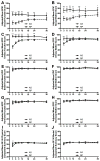Prospective quality-of-life outcomes for low-risk prostate cancer: Active surveillance versus radical prostatectomy
- PMID: 25845467
- PMCID: PMC4490040
- DOI: 10.1002/cncr.29370
Prospective quality-of-life outcomes for low-risk prostate cancer: Active surveillance versus radical prostatectomy
Abstract
Background: For patients with low-risk prostate cancer (PCa), active surveillance (AS) may produce oncologic outcomes comparable to those achieved with radical prostatectomy (RP). Health-related quality-of-life (HRQoL) outcomes are important to consider, yet few studies have examined HRQoL among patients with PCa who were managed with AS. In this study, the authors compared longitudinal HRQoL in a prospective, racially diverse, and contemporary cohort of patients who underwent RP or AS for low-risk PCa.
Methods: Beginning in 2007, HRQoL data from validated questionnaires (the Expanded Prostate Cancer Index Composite and the 36-item RAND Medical Outcomes Study short-form survey) were collected by the Center for Prostate Disease Research in a multicenter national database. Patients aged ≤75 years who were diagnosed with low-risk PCa and elected RP or AS for initial disease management were followed for 3 years. Mean scores were estimated using generalized estimating equations adjusting for baseline HRQoL, demographic characteristics, and clinical patient characteristics.
Results: Of the patients with low-risk PCa, 228 underwent RP, and 77 underwent AS. Multivariable analysis revealed that patients in the RP group had significantly worse sexual function, sexual bother, and urinary function at all time points compared with patients in the AS group. Differences in mental health between groups were below the threshold for clinical significance at 1 year.
Conclusions: In this study, no differences in mental health outcomes were observed, but urinary and sexual HRQoL were worse for patients who underwent RP compared with those who underwent AS for up to 3 years. These data offer support for the management of low-risk PCa with AS as a means for postponing the morbidity associated with RP without concomitant declines in mental health.
Keywords: active surveillance; prostate cancer; quality of life; radical prostatectomy; survivorship.
© 2015 American Cancer Society.
Conflict of interest statement
The authors have no financial interests to disclose.
Figures


Similar articles
-
A prospective study of health-related quality-of-life outcomes for patients with low-risk prostate cancer managed by active surveillance or radiation therapy.Urol Oncol. 2017 May;35(5):234-242. doi: 10.1016/j.urolonc.2016.12.015. Epub 2017 Jan 19. Urol Oncol. 2017. PMID: 28110975
-
Sexual function with localized prostate cancer: active surveillance vs radical therapy.BJU Int. 2012 Oct;110(7):1032-9. doi: 10.1111/j.1464-410X.2011.10846.x. Epub 2012 Jan 19. BJU Int. 2012. PMID: 22260273
-
Long-term health-related quality of life after primary treatment for localized prostate cancer: results from the CaPSURE registry.Eur Urol. 2015 Oct;68(4):600-8. doi: 10.1016/j.eururo.2014.08.074. Epub 2014 Sep 18. Eur Urol. 2015. PMID: 25242555
-
Active surveillance and surgery in localized prostate cancer.Minerva Urol Nefrol. 2014 Sep;66(3):175-87. Epub 2014 May 28. Minerva Urol Nefrol. 2014. PMID: 24867314 Review.
-
Patient-reported outcome (PRO) questionnaires for men who have radical surgery for prostate cancer: a conceptual review of existing instruments.BJU Int. 2017 Oct;120(4):468-481. doi: 10.1111/bju.13896. Epub 2017 May 30. BJU Int. 2017. PMID: 28437031 Review.
Cited by
-
Radical Prostatectomy: Sequelae in the Course of Time.Front Surg. 2021 May 28;8:684088. doi: 10.3389/fsurg.2021.684088. eCollection 2021. Front Surg. 2021. PMID: 34124138 Free PMC article. Review.
-
Quality of life among men with low-risk prostate cancer during the first year following diagnosis: the PREPARE prospective cohort study.Transl Behav Med. 2018 Mar 1;8(2):156-165. doi: 10.1093/tbm/ibx005. Transl Behav Med. 2018. PMID: 29425377 Free PMC article.
-
Caution with Use of the EPIC-50 Urinary Bother Scale: How Voiding Dysfunction Modifies its Performance.J Urol. 2017 Dec;198(6):1397-1403. doi: 10.1016/j.juro.2017.07.041. Epub 2017 Jul 18. J Urol. 2017. PMID: 28728989 Free PMC article.
-
Factors Influencing Men's Choice of and Adherence to Active Surveillance for Low-risk Prostate Cancer: A Mixed-method Systematic Review.Eur Urol. 2018 Sep;74(3):261-280. doi: 10.1016/j.eururo.2018.02.026. Epub 2018 Mar 26. Eur Urol. 2018. PMID: 29598981 Free PMC article.
-
Active Surveillance in Younger Men With Prostate Cancer.J Clin Oncol. 2017 Jun 10;35(17):1898-1904. doi: 10.1200/JCO.2016.68.0058. Epub 2017 Mar 27. J Clin Oncol. 2017. PMID: 28346806 Free PMC article.
References
-
- Aizer AA, Paly JJ, Zietman AL, et al. Models of care and NCCN guideline adherence in very-low-risk prostate cancer. J Natl Compr Canc Netw. 2013;11:1364–1372. - PubMed
-
- Klotz L, Zhang L, Lam A, Nam R, Mamedov A, Loblaw A. Clinical results of long-term follow-up of a large, active surveillance cohort with localized prostate cancer. J Clin Oncol. 2010;28:126–131. - PubMed
-
- Wright JL, Lin DW, Cowan JE, Carroll PR, Litwin MS, Ca PI. Quality of life in young men after radical prostatectomy. Prostate Cancer Prostatic Dis. 2008;11:67–73. - PubMed
-
- Wilcox CB, Gilbourd D, Louie-Johnsun M. Anxiety and health-related quality of life (HRQL) in patients undergoing active surveillance of prostate cancer in an Australian centre. BJU Int. 2014;113:64–68. - PubMed
Publication types
MeSH terms
Grants and funding
LinkOut - more resources
Full Text Sources
Other Literature Sources
Medical
Research Materials

